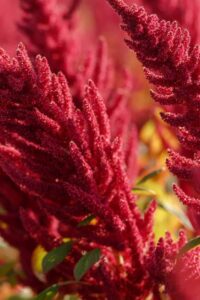Kodo millet, originally from tropical Africa, is thought to have been cultivated in India some 3000 years ago. The kodo millet (Paspalum scrobiculatum) is widely grown in India, Pakistan, the Philippines, Indonesia, Vietnam, Thailand, and West Africa. Kodo millet originates in India and is grown on poor soils in arid and semi-arid regions of India and Africa. Kodo millet, also known as cow grass, rice grass, ditch millet, Native Paspalum, or Indian Crown Grass, is commonly farmed by tribal people in small places across India under various names (kodo, khoddi, arugu, varagu), and mandal in Pakistan. Kodo millet is rich in vitamins, minerals, sulfur-containing phytochemicals, and important amino acids such as lysine, threonine, valine, and sulfur-containing amino acids. High fiber, polyphenols, and protein content can improve nutritional security for many people. Kodo millet has the highest dietary fiber concentration, making it an excellent choice for people with diabetes. This food is high in protein, low in fat, and contains vitamins such as folic acid (B9), niacin (B3), and pyridoxine (B6), as well as minerals like calcium, iron, magnesium, potassium, and zinc. Kodo millet is high in dietary fiber, iron, and antioxidants. Kodo millet has a lower phosphorus content and stronger antioxidant potential compared to other millets and grains. Kodo millets can be used for both traditional and new dishes. Grains, whether unprocessed or processed, can be boiled whole, decorticated, and milled into flour using conventional or industrial methods. In India, kodo millet flour is used to make puddings. Tribal populations cook it as rice and create other cuisines using flour. In Africa, it’s cooked like rice. It is suitable for feeding cattle, goats, pigs, sheep, and poultry. It offers potential for food production on hillside farms. Research suggests that kodo flour can be used in traditional and novel food products such as idli, dosa, chappathi, pongal, puttu, idiyappam, kozhukattai, boli, biscuit, soup, adai, payasam, cutlet, biscuits, bread, cookies, and laddoo. This gluten-kodo flour can be used to make leavened bread by adding hydrocolloids that mimic gluten properties.
Kingdom: Plantae
Order: Poales
Family: Poaceae
Genus: Paspalum
Species: scrobiculatum

-
- Vernacular Name: Local names for kodo vary by country, including Kodo in Bengali, Kodra in Gujarati, Punjabi, and Marathi; Kodon in Hindi; Harka in Kannada; Kodua in Odia; Varagu in Tamil; and Arikelu and Arika in Telugu.
- Origin: Kodo millet, an ancient grain that originated in Africa and was domesticated in India several thousand years ago, is a drought-resistant plant. This millet crop is produced in arid and semi-arid locations across Africa and Asia. Kodo millet is primarily farmed in India’s Deccan region, but also in the Himalayan foothills.
- Plant parts: Crops may be annual or perennial. Tasseled stems range in height from 30-90 (-150) cm, are thin to strong, upright or reclining, and have roots at lower nodes. Leaf sheaths are often glabrous because they are compact and keeled. The leaf blades are 10-40 × 0.4-1.2 cm and are either linear or lanceolate. They are usually glabrous, with subrounded scabrous margins, an acuminate apex, and a ligule measuring 0.5-1 mm. A cluster of two to five (-8) subdigitate racemes on a short axis; racemes 3 to 10 cm, ascending to widely spreading; spikelets normally solitary, overlapping in two rows, but rarely paired, particularly in the middle of the raceme; rachis ribbonlike, 1.5 to 3 mm broad, with scabrous edges.
Subequaling spikelets with bottom lemma that is membranous or sometimes indurate, obtuse, coriaceous, coarsely striate, and 3-5(-7) veined; top lemma that is 2-3 mm, glabrous, obtuse to apiculate, suborbicular, ovate or broadly elliptic, and brown when mature. 3–7 veined, membranous top glumes. With 2n = 20, 40, or 60, from May to November.
- Geographical area: The kodo millet (Paspalum scrobiculatum) is also referred to as cow grass, rice grass, ditch millet, Native Paspalum, or Indian crown grass.
It is cultivated in India, Pakistan, the Philippines, Indonesia, Vietnam, Thailand, and West Africa. It is a popular food source in the Deccan plateau of India, including Gujarat, Karnataka, and portions of Tamil Nadu, as well as in Maharashtra, Odisha, West Bengal, Rajasthan, Uttar Pradesh, and the Himalayas. It is also traditionally consumed as a health and vitality meal in rural India. Kodo millet is grown on around 907,800 acres and produces around 310,710 metric tons per year. Madhya Pradesh and Tamil Nadu dominate the production and promotion of kodo millet. The government of MP is actively promoting and selling this crop.
- Functional properties:
- Nutritional value: Kodo millet is a nutritional alternative to rice and wheat. The nutritional breakdown of different cereal crops. Protein, fiber, and mineral levels are significantly higher than rice and other main cereals. Kodo millet grain has 8% protein. Glutelin is the main protein found in kodo millet. Kodo millet has higher fiber content (9%), compared to rice (0.2%) and wheat (1.2%). Kodo millet has 66.6g of carbs and 353 kcal per 100g of grain, similar to other millets. It also has 1.4% fat and 2.6% minerals. The iron concentration of kodo millet ranges from 25.86 ppm to 39.60 ppm.
- Medicinal use: Kodo millets contain high magnesium levels, which have been related to a lower risk of heart attack. Millets contain phytochemicals, notably phytic acid, which can reduce cholesterol and prevent cardiovascular disease by lowering plasma triglycerides. Kodo millets are an excellent grain to include in your diet for heart health, a common concern. Magnesium, found in Kodo Millet, helps lower blood pressure and reduces the incidence of heart attacks and strokes, particularly in cases of atherosclerosis.
- Kodo Poisoning: Kodo grain is known to be harmful to both cattle and humans. Fungus can cause grain poisoning. Paspalum ergot, a fungal illness, can induce uneasiness, a lack of muscle coordination, gait instability, spasms, depression, and even death in animals. Kodo-poisoning in humans can produce nausea, vomiting, delirium, depression, drunkenness, and coma.


